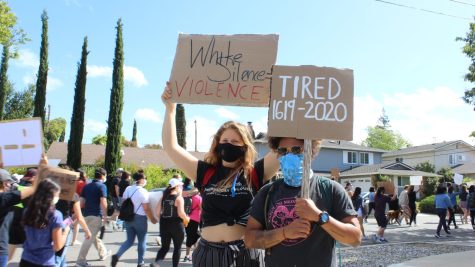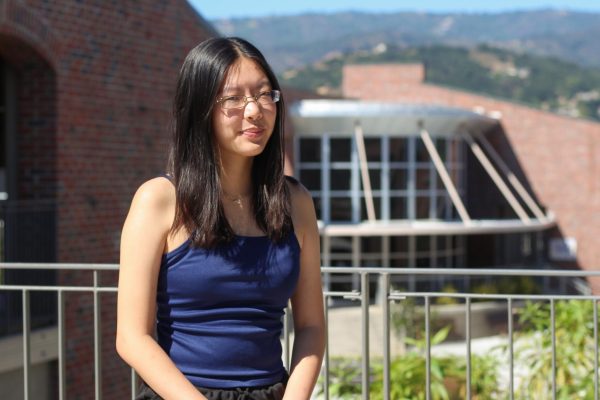Black Lives Matter
Exploring how the BLM movement has changed things at MVHS in recent years
Ayah Ali-Ahmad | Used with permission
A large crowd of protestors march forward during a rally.
April 22, 2022
On Thursday, March 10, junior Greyson Mobley found that the bathroom in the lower B building at MVHS had been graffitied with the phrase “Kill all n******.” He perceived the act as “stupid and childish,” but the incident left him wondering about the progress towards racial equality at MVHS in the past few years. This incident, however, was not the only time he felt he was the recipient of racial harassment.
One day, while working on miscellaneous assignments in AVID, his entire class started getting loud. However, Mobley and the only other African American student in the classroom felt they were singled out by the substitute teacher and were told not to “cause a scene,” despite the fact they were both “relatively quiet” and “working diligently.” Mobley was especially bothered by his perception of the lack of consequences in response to these incidents. While he did not report the occurrence in his AVID class, he did report the graffiti in the bathroom.
Principal Ben Clausnitzer states that the administration has been unable to determine the perpetrator of the bathroom graffiti, and has therefore been unable to impose any consequences. He also notes that the type of punishment varies on a case-to-case basis. However, if the perpetrator is identified, the consequences would likely entail suspension and potentially expulsion because “in a situation like this, [he] can’t see any way where someone would remain on campus.”
Superintendent Polly Bove highlights how administration has worked on transparency by sending out messages about incidents like this to all students and families, whereas students may not have been recipients in the past.
That’s something we’ve learned over time,” Bove said. “I don’t want to tell you we started out being incredibly insightful about knowing that that was a big step to take, but it really was a learning that we took seriously. We still have our own processes, but we want to work that through and we want to do our best to find who’s doing these things, and then address it.”
Still, Mobley feels there is a lack of investigative work he believes the administration should be doing.
“They should definitely make it more of a big deal instead of sending out one email,” Mobley said. “We haven’t really done anything to stop it, [so] I think [we should] take more action and try to figure out who it was and solve their behavior.”

Clausnitzer states that as no new information has been reported regarding the graffiti incident, the administration has been unable to progress its investigation. However, he understands that some individuals may still want to learn more about the incident and invites them to contact him.
“It’s always helpful if someone is feeling that they’d like more information that they reach out to us,” Clausnitzer said. “They reach out to me and say, ‘Hey Mr. Clausnitzer, I’d love to be able to engage in a conversation with you. I want to just chat more about this with you.’ It’s important for me to hear how they’re feeling and what they’re thinking, the voice of our students, the voice of our families, the voices of our staff. It’s important to me, it helps me learn and grow as a leader as well.”
Associate Superintendent Tom Avvakumovits says the administration is constantly finding ways to improve its “focus on inclusion and equity.” He adds that recently, the district has taken some notable steps toward fostering a more inclusive environment for all their students. “I used to be a teacher at Cupertino High School, and in our sophomore year, and this was a zillion years ago, all of our authors except one were people who looked like me and Mr. Clausnitzer,” Avvakumovitz said. “So there’s been a huge movement, [and] we need to look at literature in ways where we diversify the perspectives, and so now in all of our English classes throughout all five of our comprehensive high schools there’s much more inclusion of perspectives of color.”
Principal Ben Clausnitzer articulates that the administration has since also implemented Equity Task Forces, groups of students and staff that work to address racial inequality in all five high schools in the district.
“That commitment that we are thinking about is transformational, and we’re talking about equity [and] social-emotional learning,” Clausnitzer said. “We still have to have a focus and need to have a focus around racial equity. We can’t lose that. As the Equity Task Force, the importance is focusing on racial equity during that work [and] what became our focus and continues to be.”
On Monday, April 4, the Task Force at MVHS held a meeting to focus on the future of inclusivity on our campus. The attendees, consisting of 26 students and nine staff members, participated in an activity where they imagined that they had the ability to change whatever they desired around campus regarding equity and inclusivity, wrote those ideas on posters and post-its and then walked around the room while interacting with each poster. Their next step involved the digitization of these ideas and grouping ideas into general categories. For example, if an idea referenced technology and racial equity, it would be placed in a group with other similar ideas. Clausnitzer explains that the goal of this process is to synthesize these goals and identify time frames in which they can be achieved.
“We’re trying to let this be a process of truly being transformative for outcomes for our students,” Clausnitzer said. “While habits may be performative — performative could be doing something for the sake of doing it or doing it to tell others you’re doing it right — we’re truly trying to listen to the student voice, listen to staff with a focus on being transformative, to truly have that positive impact for our students. So that’s kind of where we’re at in our Equity Task Force and Social Emotional Learning work.”
While the Equity Task Force seeks to educate students on how to become more inclusive and creates plans for the future of inclusivity on campus, Mobley believes that the root cause of these racist incidents stem from a deeper issue. Although he feels that racism is prevalent in the culture at MVHS, he thinks it is well concealed due to California being a largely Democratic state. He notices that as a result, it is harder to solve these issues of racism.
“I think the racism around here, especially, is a lot less noticeable because people know it’s not OK, so they hide it,” Mobley said. “But it’s very obvious that it’s still a problem because of, obviously, what happened. And then there’s also just little prejudices that are pushed through the media and stuff like that that’s kind of ingrained in all of our heads.”
Mobley sees a similar trend of performative allyship in the BLM movement at MVHS, recalling seeing many students put “BLM” in their social media bios. However, he saw it as more of “a trend” rather than real support for the movement due to how quickly they forgot about it and the continued racism at MVHS.
Avvakumovitz understands the struggles Mobley identifies, and highlights how the administration is focused on continuously growing and improving to make schools in the district more inclusive.
“This is my 29th year in the district, and ever since I started, we’ve had a strong focus on inclusion and equity,” Avvakumovitz said. “But for me, I think what BLM did is an example of ‘Hey, some of the initiatives that we’ve been working on, maybe need to be more explicit and direct about the work we are striving to do and continue to work to do.’ [It] really does address or attempts to address the concerns of some of the less-represented cuts of students, including African Americans.”





























